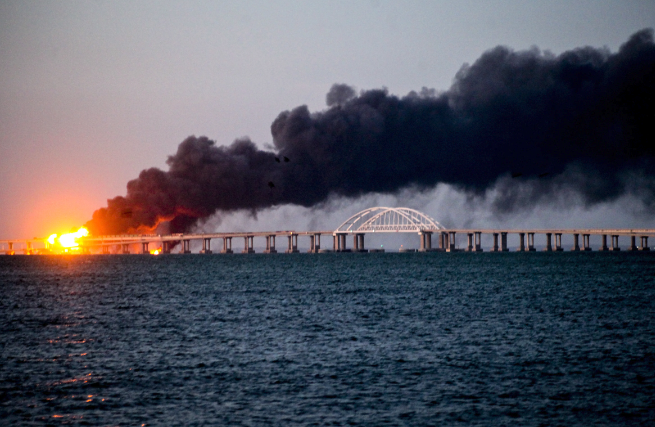Ukrainian forces have conducted consecutive strikes on a bridge in Russia’s Kursk region, as evidenced by recently surfaced video footage. The initial attack, believed to have utilized High Mobility Artillery Rocket Systems (HIMARS), was captured by unmanned aerial vehicles operated by the Khorne Group, a Ukrainian tactical drone unit associated with the 116th Mechanized Brigade.
The footage, shared on Telegram and subsequently distributed across various social media platforms, depicts multiple projectiles impacting the Seym River Bridge near the village of Karyzh. The munitions appear to disperse across the target area, striking both the bridge structure and the surrounding water. Following the barrage, the video zooms in to reveal significant damage inflicted upon the bridge.
In a follow-up operation the next day, additional footage emerged showing what analysts believe to be a strike using Joint Direct Attack Munition – Extended Range (JDAM-ER) weapons. These precision-guided munitions, supplied by the United States, are designed to convert unguided bombs into accurate strike options. The JDAM-ERs are typically launched from aircraft and have been previously employed to target bridges within Russian territory.
The second attack video appears to show more extensive damage to the bridge, with a visible hole in the structure, although the bridge remains standing. While Business Insider could not independently verify the specifics of the strike footage, open-source intelligence accounts have geolocated the incidents to the Karyzh area in Kursk.
This is not an isolated incident, as Ukraine has previously targeted bridges in the Kursk region. Late last month, Ukraine’s air force released video footage showcasing a Soviet-era MiG-29 aircraft deploying US-made GBU-62 JDAM-ER bombs against bridge crossings in Kursk. These weapons bear similarities to Russia’s glide bombs, which have been used to devastating effect against Ukrainian positions, particularly during Russia’s offensive in Avdiivka where they contributed to temporary Russian air superiority.
Ukraine’s strategy of targeting these bridges appears aimed at disrupting Russian logistics and supply lines in the area. This comes as Moscow continues to redirect its forces to Kursk in response to Kyiv’s ongoing invasion efforts.
The use of precision-guided munitions and advanced rocket systems highlights the evolving nature of the conflict, with both sides employing sophisticated weaponry to gain tactical advantages. The strikes on infrastructure such as bridges demonstrate Ukraine’s intent to hinder Russian military movements and potentially isolate frontline forces from resupply and reinforcement.
As the conflict continues, the targeting of critical infrastructure like bridges is likely to remain a key tactic in Ukraine’s efforts to impede Russian military operations. The repeated strikes on the same bridge underscore the strategic importance of these crossings and the determination of Ukrainian forces to render them inoperable.
The international community continues to watch closely as the situation unfolds, with particular attention paid to the use of Western-supplied weapons systems in strikes against Russian territory. The ongoing attacks on bridges in Kursk serve as a reminder of the complex and dynamic nature of the conflict, as both sides seek to gain advantages through strategic targeting and the application of advanced military technologies.

